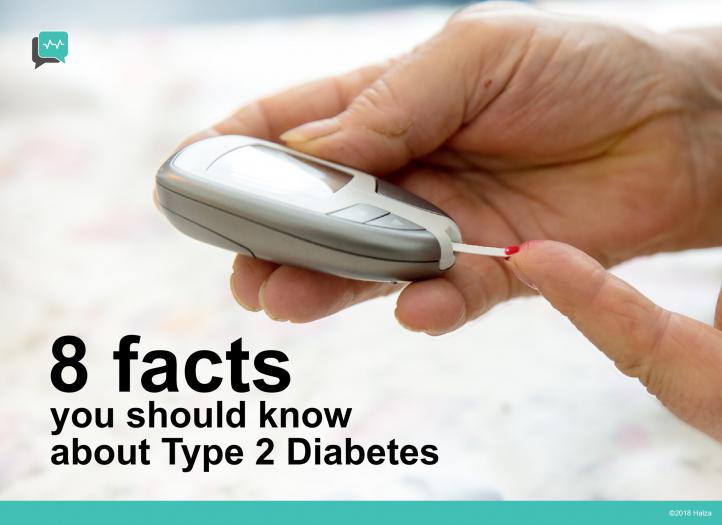8 Facts You Should Know About Type 2 Diabetes

Diabetes is a disease that has become increasingly prevalent, rising from 108 million cases worldwide in 1980, to 422 million in 2014 – and this number is only set to rise. According to the World Health Organisation, diabetes will likely be the seventh highest leading cause of death by 2030.
Many of us already know that people with diabetes need to monitor the amount of carbs and sugar that they eat – but beyond that, what exactly is this disease about? Read on to better understand the disease, and what you can do to prevent it.
1. Diabetes is when blood sugar levels are higher than normal

Type 2 diabetes is caused by:
1) Cellular resistance to insulin
2) A reduction in insulin production
Insulin is a hormone made by the pancreas. Without it, our cells can’t convert food into energy.
Insulin acts as a key that unlocks the cell doors. Once unlocked, glucose – a form of sugar – can enter the cell where it is used to make energy. If insulin is not available, the sugar builds up in the bloodstream. This buildup of sugar over time can lead to other complications like blindness, kidney disease, cardiovascular disease, and poor wound healing.
2. Type 2 diabetes is the most prevalent form of diabetes
Approximately 90% of people with diabetes have Type 2. Type 2 was formerly known as ‘adult onset diabetes’ or ‘non-insulin dependent’ diabetes. However, the incidence of Type 2 is rising among children, and most people with Type 2 will eventually need insulin as the disease progresses.
Risk factors for developing Type 2 diabetes include being overweight and/or sedentary, and having a family history of the disease. Treatment includes lifestyle modifications such as diet and exercise, medication, and/or insulin.
3. Symptoms of Type 2 Diabetes include urinating often and unusual thirst
Symptoms of Type 2 diabetes usually take some time to show, so the disease is often only diagnosed after damage to the body has occurred. If you are experiencing any of these symptoms, visit your doctor for a simple blood test.
- Urinating excessively
- Feeling unusually thirsty or hungry
- Altered vision
- Infections and sores that heal slowly
- Dry skin
- Headaches
- Fatigue
- Numbness, pain or tingling sensations in hands and feet
4. Type 2 diabetes can be treated with medication or insulin injections, diet, and exercise
Oral or injectable medication can help people with Type 2 diabetes to lower blood sugar levels. Insulin, alone or in addition to other medications, can be injected at home. Particularly if taking insulin or a medication that increases insulin production, blood sugar levels should be monitored with an at-home testing kit.
In addition to taking medication, it is important to exercise and watch what you eat. Speak with your health care provider about dietary recommendations that will help to lower blood sugar levels. You can also ask about beginning an exercise program. Exercise helps to reduce cellular resistance to insulin. In addition, losing weight – even just a few kilos – can have a significant affect on blood sugar.
5. It is often possible to prevent Type 2 diabetes from developing

If your doctor has told you that you are pre-diabetic, this means that you have a very good chance of developing Type 2 diabetes. Pre-diabetes is reversible, whereas diabetes is a progressive disease that is manageable but not reversible. Developing a good fitness routine and changing your eating habits can help prevent pre-diabetes from becoming diabetes.
If you’re used to a sedentary lifestyle, it’s time to hit the gym. It’s not going to be easy at first, but start small, and gradually increase the intensity of your exercises as you go along.
6. Carbohydrates are necessary in your diet but can cause blood sugar spikes. Choose them wisely.

All carbohydrates are converted in the body to glucose. Glucose is the sugar that enters the cell to be used for energy production. However, some carbohydrates such as sugary or starchy foods will produce an immediate blood sugar spike, followed by a drop. Carbohydrates such as whole grains or vegetables will produce a slower and steadier rise in blood sugar, with more nutrients and fiber than their sugary cousins.
That said, you don’t have to be overly paranoid about every single thing you eat. You can still indulge in sugar-free or low-sugar desserts in moderation when cravings strike. Click here for a list of food myths for diabetes patients, debunked.
7. Diabetes can damage other organs and increase chances of strokes
The complications that can arise from poorly managed diabetes include kidney failure, blindness, cardiovascular disease, poor wound healing and poor circulation, nerve damage, impaired digestion…and the list goes on. If you have diabetes, please make sure to work with your health care provider to prevent these complications from developing.

8. Diabetes runs in families
If you have family members – especially parents or siblings – with a history of diabetes, or even a history of obesity, you’ll be at higher risk, so do pay attention to any warning signs. Even better, before you have warning signs, go for regular checkups.
Type 2 Diabetes – a disease that can be prevented with good habits

As we lead increasingly sedentary lives in front of the sleek screens of our smartphones, computers, and TVs, it’s important to remember to unplug once in a while, and head outside to be active with some good ol’ exercise.
And in the age where processed food is abundant, try to whip up your own balanced meals with healthier ingredients instead of doing oily, starch-heavy takeaways too often – your body will thank you.


